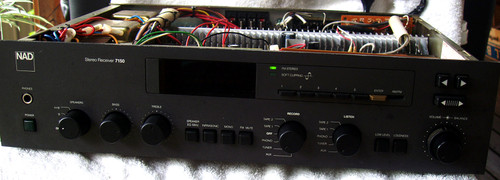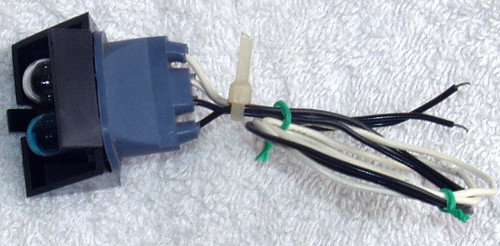EQUIPMENT HISTORY:
Everything I am describing below is IMPORTANT, read it please!
This amplifier is part of my "collection" of all things audio, both professional and consumer gear. I personally don't mind a decent NAD piece of gear and actually had a number of these 7150 series receivers, this particular unit was a "to be looked at" as it is NOT WORKING CORRECTLY - see the FULL details below.
Like many NAD amplifiers, these 7150 receivers surprise many. They use a design which results in an amplifier that easily produces far greater audio output than the listener could be expecting.
Another aspect of the 7150 which is often overlooked is the (then) newly developed Tuner system called Schotz Variable Bandwidth. This sophisticated FM detector system is described in more detail below, in the testing section.
I have over the years collected together a LOT of quality audio equipment due to my business activities in pro audio post production and general electronics but the day has finally arrived!
My wife says "for goodness sake, get rid of that mountain of gear" so them's my orders ... out they all go.
This is my last NAD 7150 series receiver, 6x NAD amplifiers/receivers have found new homes now (Yeah!) and after this one, no more ... Oh except a lovely old 7155 which I run in my little workshop for testing! Just can't leave those NAD's alone...
This equipment does have issues, and it is extremely important that the complete description is read in full.
THE CONDITION OF THIS EQUIPMENT IS CLEARLY STATED BELOW, BOTH COSMETICALLY AND ELECTRICALLY
There is no warranty, there are no returns - but I am very thorough and do not "gloss over" any issues I might discover!
Even if the new owner doesn't feel up to repairing or having this equipment repaired, it's is still a great source of some very hard to find parts.
I love details, lots of them, but it has been suggested I summarise the equipment condition and then go into the details .... so...
NAD 7150 SUMMARY:
Overall, electronically the 7150 Receiver is in pretty good condition.
Big Tick for the power amplifier and the preamplifier section (albiet the dodgy Volume/Balance control)
The Tuner/Display board is the biggest electronic problem (as detailed above) None of the components are difficult to source or special but it will take a bit of time to resolve the Tuner board power supply issue.
Top of the case has been found, no longer a problem!
More minor are the missing AM/FM button and the spring loaded speaker terminal on Set B outputs
I can easily ship this equipment anywhere around Australia (INCLUDED in the asking price)
NAD Stereo Receiver
Model: 7150
Released from the factory 1983
Serial # N7507328
Dimensions: 420mm x 96mm height x 310mm
Weight (unpacked): 9Kg (packed in the box) 11Kg
Australian version, fitted with Australian GPO plug (normal 3 pin with earth)
The rear labelled as 240V/50Hz
The AC transformers are 29-2072-7, 29-2072-7A, 28-2070-1 which are for the E2/E3/E4/U3/U4 versions
BASIC SPECIFICATIONS:
Power output 60W RMS per channel into 8 Ohms
Now this can be very deceiving when it comes to NAD equipment! These amplifiers have very high dynamic-headroom ratings and are able to drive very low load impedances (such as 2 ohms) at surprisingly high power levels without clipping or other distortion.
The "real life" clipping-output ratings (across the audio spectrum 20Hz ~ 20Khz) are:
65 watts into 8 ohms
75 watts into 4 ohms
85 watts into 2 ohms
These are all your industry standard RMS ratings but if you look at the dynamic power ratings, they are:
100 watts into a 8 or 4 Ohm load
130 watts into a 2 Ohm load
In real life this means that if your music has a wide dynamic range and at times (when a heavy demand is placed on the audio output section to delivery much greater audio power) the 7150 easily takes it in it's stride without falling into a horrible distorted mess.
But wait! there's more ...
This 7150 has bridging capabilities (switch on the rear panel which allows you to create a HIGH OUTPUT MONO amplifier)
When bridged you can expect 125 watts RMS with up to 150W before clipping OR 225W Dynamic power into a standard 8 Ohm load.
On the rear panel is a slide switch, NORMAL or LESS THAN 8 OHM LOAD - pretty unusual and I had a look at the circuit diagram and tested its function. It lifts the DC supply higher in voltage! That is the whole purpose of this switch.
Frequency response (3dB points) 10Hz ~ 35Khz
Damping factor: 100
Maximum Total Harmonic Distortion (THD) at full power into 8 Ohm load: 0.03%
Inputs: Phono (turntable), AUX, Tape 1, Tape 2
Phono input is switchable between Moving Coil and Moving Magnet
Signal to Noise ratio: 68dB (worst case Phono MC and best case 95dB Line level inputs)
Preamplifier to Power Amplifier U links, meaning you can easily operate the two sections independently of each other.
2 section tone controls (Bass, Treble)
OFF, A or B or A+B speaker switching at the front panel
Speaker outputs are all spring loaded terminals.
COSMETIC CONDITION:
In a nutshell, Wow factor is 9/10!!!
I used this 7150 until about 10 years ago, then it failed me (see below for details) and I put it back in the "backroom" where it has stayed ever since.
Never abused, always used (until it developed a fault).
I still use a 7155 receiver everyday here in my little workshop/office and they are wonderful beasts!
The frame and base cover is straight and true, no dropping has occurred (although it is quite heavy, carry with care!)
Top case is in average condition, light signs of oxidisation but nothing too serious.
Base panel is clean sheet steel, no corrosion signs at all (always look underneath an amp to get clues as to how it has been treated)
All knobs are correct and accounted for!
ISSUE 1: ALMOST all of the Tuner section push buttons are present EXCEPT the AM/FM select button - it is missing! The very delicate spring is still present (it will be supplied) but the thin button is missing.
All rear panel sockets/switches are the same way.
ISSUE 2: While the spring loaded speaker terminals for the A SET are fine, one piece of plastic has broken on the B SET, making them pretty hard to use. If you are like most people, just using the A Set is the norm anyway.
Front panel display is clean, clear and unscratched.
TESTING:
Ah this is the part that really matters....
Gathered together some nice sound sources, Marantz CD player and a Technics turntable running with a SHURE VI cartridge. Multimeter at the ready!
Both the top and base covers are off, I want to look at the condition of the boards, any mods or repairs and watch out for failed or failing components.
Two large PCB's, the upper being the Tuner/Display etc and the lower is the preamplifier/power amplifier and masses of switching!
The three AC power transformers all sit tucked away on the left hand side of the amplifier chassis.
Visual inspection shows that the 7150 is clean and free of excessive dirt/dust both "on top" and underneath.
Looking at the main PCB and topside of the Tuner board, I cannot see evidence of someone working on these boards - at first glance, see below for later discoveries.
No obvious electrolytic cap "popping/bulging" or overheated/burnt areas of the boards that are readily visible. No leakage from the electro's, just that horrible glue that NAD used to secure the main supply filter caps (4 of them)
With just a visual look around, it seems in pretty good shape
Enough "looking", let's fire it up!
Testing undertaken at 240V AC input
Initial testing was as a split system, first the Preamp section and then linked to the Power Amplifier at the rear.
Power ON switch working (locking) fine, green LED comes on.
ISSUE 3: the display does not "come alive" ... more about that further down.
Protection relay operates as normal after 1 ~ 2 seconds.
PREAMPLIFIER TESTING ONLY
I then wound up the volume to "10" the maximum level with NO audio inputs, listening on my separate power amplifier very closely for background hum. Nothing of any significance heard so this indicates that at least the main filter caps/power supply are doing their job filtering the DC main rail.
I then wound back the volume, switched to AUX, TAPE 1 and TAPE 2 inputs successively and was greeted with wonderful "NAD sound" - so nice and clean, NO distortion and plenty of grunt! I wound up the system level and no signs of any problems at all.
ISSUE 4: While rotating the Volume & Balance concentric control I did hear some "dead" spots where the Left channel would drop out. this indicates a dirty "track" or two which may be fixed with a good squirt of cleaner or sometimes it is better to replace the pot.
As these pots are tucked away and not easy to reach without dismantling, I left them alone (uncleaned).
Switched to Phono, hoping for good things as I do like the Phono sections of these amplifiers but alas, NO SOUND. Shame because these Phono's are MC/MM compatible with switchable load capacitance too - nice touch.
The Phono section uses a plug-in Phono card (horrible design idea, I have had lots of issues with those cards over the years) mainly due to the NICKEL PLATED plug/socket arrangement (molex style connector) which has NO real securing mechanism, nor is it "keyed" - if removing, be careful to make sure all pins are aligned properly. The card just sits in the socket and is prone to movement causing issues. This seems like pretty poor engineering design, NAD, when you are dealing with extremely low level audio signals there is no way cards should be like this - BIG minus for effort NAD.
I pulled out the Phono board to have a look at it and it is a AE3 type, with not only plug in connections but some hard wired cabling as well. Cleaned the connectors on the Phono board and the main PCB and reinserted the card.
Powered up once again and hey presto! Phono section has sprung to life - vinyl is back on the menu!
POWER AMPLIFIER SECTION TESTING (Linked at the rear)
ISSUE 5: Prior to connecting my precious Vifa loudspeakers, I checked both outputs for the dreaded DC voltage being present, one channel is as it should be but the Left channel shows around 1V which is out of specification, being a bit high, DC offset adjustment is needed here.
Never ever should you see any substantial DC voltages at your amplifier speaker outputs because if you connect your prized speakers to such an amplifier, your speaker voice coils suddenly turn into little heaters and then go POOF! This is something you must prevent at all costs - ALWAYS check an unknown amplifier for DC at the speaker outputs before connecting your speakers.
I decided to connect my test loudspeaker system briefly to at least get an idea of power amplifier functionality (or not)
This amplifier uses a pair of 2SC2921/2SA1215's (Sanken) in each channel output, these are originals and have never been changed (any service work, not matter how professional always leaves behind little tell-tale signs of work having been undertaken)
I had the base plate off so I took the opportunity to look at the DC supply rails, all fine and measure 44.6 - 0 - 44.4
Wound up the volume and I was greeted with lack of audio until I moved the Volume/Balance control slightly - it then sprung into life (both channels)! Not distorted on either channel although I felt that the Left Channel didn't sound quite the same but that may be due to a resetting of the DC offset and Bias being required or simply associated with that Volume/Balance issue. So the previously mentioned Issue 5 is pretty noticeable in reality - this needs attention unless you want to be forever "fiddling" with the control to get the Volume & Balance correct.
At this point I am relieved and delighted that the power amplifier is fully functioning - very nice indeed!
AM-FM RECEIVER & DISPLAY BOARD:
A bit more detail about this problem which I refer to above as ISSUE 3
Lack of display...
This is all part of the top board, the tuner/display section - that is all it does.
Ok no display at all and when switching to TUNER, no audio either.
First I checked the AC power to this Tuner board coming from the "FEDERAL baby transformer", both supplies look fine.
I then looked at the regulator section (top near the power amplifier heatsink with 2x fuses) and it is around here that I am not getting expected readings.
Basically the board has no or incorrect DC supply rails to both the tuner section and the display module.
Funny thing about this Tuner board, I had another 7150 (now sold) but it had a different Tuner board layout - I have no idea why.
My instructions (from the wife) was not to spend too much time on these things but I was really curious about that regulator section, it looks a little "dark" topside. After undoing the multitude of screws, released the side metal strip, I can lift the board up and out of the way and take a look underneath.
Ah huh! Someone has been messing around this section and not done a great job either! They managed to cook a couple of tracks and have bridged them with wire - it all looks a bit messy. So work is needed in this area for sure.
Observation: I have had a few of these 7150's and it seems to be always the Tuner board that fails and most often, this regulator section is the culprit. I suspect it is a bit "under-designed" to handle the current requirements.


















